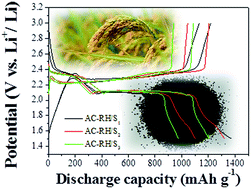Activated carbon with hierarchical micro–mesoporous structure obtained from rice husk and its application for lithium–sulfur batteries
Abstract
Rice husk is one of the most earth abundant, low-cost, and eco-friendly agricultural residues. In this study, we successfully synthesized micro/mesoporous activated carbon from rice husk (AC-RH) through carbonizing the rice husk and activating it with ZnCl2. Elemental sulfur was loaded to the micro/mesopores through a solution infiltration method to form an AC-RH/S composite. The obtained AC-RH/S composites with different sulfur-loading levels were tested as cathode materials for lithium sulfur (Li–S) batteries. The AC-RH/S composite with sulfur loading (AC-RH/S1) of 23 wt% showed an initial discharge capacity of 1352 mA h g−1 at 0.1 C-rate. After 100 cycles of charge/discharge at a current density of 335 mA g−1, the AC-RH/S1 composite retained a high specific capacity of 518 mA h g−1 with a capacity retention of 49%. The material delivered a capacity of 426 mA h g−1 at 2C rate. These results suggest that rice husk can be a sustainable resource for the large-scale production of activated carbon, which is a promising material for the cathodes of Li–S batteries.



 Please wait while we load your content...
Please wait while we load your content...